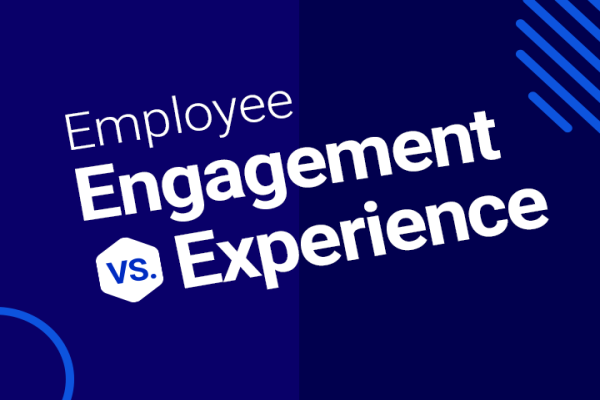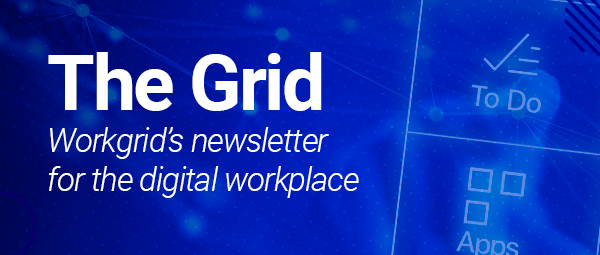Overview
In the battle to build a modern digital workplace that meets the widely varying needs of today’s workforce, it’s easy to get lost in the nuanced differences between employee engagement and employee experience. Both are critically important to employee - and business - success. But it’s important to recognize that they are not interchangeable and require a completely different approach for optimization.
For a brief refresher of Employee Engagement vs. Employee Experience:
![[asset] Employee Experience vs Engagement](https://images.ctfassets.net/z7p73u8c0thn/3C9A0nQgcv9FZPlbn0kVsl/34d5cb237681e4f078896cf197342090/ExperienceVSEngagement.JPG?w=1187&h=563&fl=progressive&q=60&fm=jpg&bg=transparent)
For the purposes of this blog, I would like to focus on the employee experience (EX), along with the digital workplace trends that will impact the success of your workforce and your business in the coming year and beyond.
The Impact of EX trends on the Digital Workplace
We all know by now the pandemic caused a significant increase in digital transformation, with technology enabling widespread remote work in a way most organizations would never have believed possible. As a result, employee expectations have shifted dramatically. People now expect to be able to work whenever and wherever it’s convenient for them, with recent studies revealing more than half preferring to work from home part of the time.
This paradigm shift will directly challenge the archaic management practices that have been holding many businesses back. The aged factory mindset of ‘presence equals productivity’ is no longer valid for most knowledge workers.
Fancy offices and state-of-the art facilities will no longer be the perks and evidence of business success. Instead, there will be an increased focus on meeting employee needs as organizations recognize the importance of EX due to its known impact on customer experience, revenue growth and the ability to attract and retain top talent.
![[asset] Employee Experience Leads to Great Customer Experience](https://images.ctfassets.net/z7p73u8c0thn/5vDOkhLhXGfxS1xs6sczy4/802fd042a99b5b9651bf0db74213b6c7/EmployeeExperienceMatters.JPG?w=747&h=356&fl=progressive&q=60&fm=jpg&bg=transparent)
EX: 'The Journey' and 'The Moments'
As internal conversations begin to accelerate around improving EX, there has been an increased interest in looking in two inter-related areas of EX- the macro ‘Employee Journey’ and deeper more nuanced ‘Moments that Matter’.
The ‘Employee Journey’ represents the entire lifecycle that begins even before an employee is hired within your organization; to when they walk out the door for the last time. With the move to more hybrid work models this refocuses the conversation on the key employment stages: pre-hire, onboarding, development, engagement, and even through offboarding. There’s a growing impetus to look deeper into the routine day-in-the-life experiences and friction points - particularly around technology touchpoints.
Taking a deeper look, if you were to stop and ask an employee what their most easily recalled workplace experiences are, they may not readily respond with the daily struggles of access, context switching, information discovery - but – more anchor on the handful of ‘Moments that Matter’ that are personal. These are the extremely impactful center-stage instants that range over the employee journey. For example, being passed over for a promotion, getting injured at work, paternity leave, sometimes even seasonal experiences like, changing benefits.
![[banner image] guide to creating an effective digital workplace](https://images.ctfassets.net/z7p73u8c0thn/6AIKTKcYiDCW7UZQqjoMyH/af19fa8b91cad6a9f91a2e5bab28c727/rob-ryan-guide-to-effective-digital-workplace-banner.png?w=780&h=200&q=60&fm=png&bg=transparent)
Listen to Rob present the formula for creating an effective digital workplace at the 2021 Digital Workplace Experience Summit
Recommendations for Building the Digital Workplace of the Future
There are many recommendations to help you take advantage of trends like these. However, all of them start from the same foundational premise:
For employee experience initiatives to be successful, it’s essential to understand how the world looks from the seat of the employee. If their world is not clearly understood, no tactic, program, or technology will be successful.
Rob Ryan, Director of Product Marketing, Workgrid Software
Take addressing 'moments that matter'. To make the most of this opportunity, organizations must understand which specific moments influence their employee’s perceptions. Since these events vary by company, employee demographics, region, etc., it isn’t as simple as applying best practices that worked for other successful companies. Each organization needs to gather their illustrations, sentiment, and stories from the perspective of their own employees. By doing so, patterns will emerge that uncover opportunities and make it clear where to concentrate EX efforts.
With these moments identified, whether it’s first week onboarding, benefits election, and others - organizations can search for ways to simplify, align, and optimize to ideal expectations.
For example, if first week onboarding has become a rather frustrating experience for employees consider how the Digital Workplace can begin to reshape these events into more positive experiences:
Do you understand the situation in the words of the employees?
What is the current state – technical and cultural?
What is the idealized state– technical and cultural?
Have we delivered a first week experience that’s personalized and contextual?
Have we centralized important acculturation points and tasks to save employees time?
Have we reduced the friction that typically comes from interacting with complex enterprise systems, processes, people?
These are the arears and improvements that need to be made for true EX and digital workplace transformation to take place.
One of the most common macro challenges is irritating context switching and a fragmented technical landscape. This can be easily mapped to the employee journey. The Digital Workplace can help reduce the friction by minimizing the time employees spend switching between apps, tasks, and projects with the help of smart notifications. Or provide immediate access to the key information employees need such as alerts, pay slips, benefits, directories, or subject matter experts.
Next, it’s important to communicate with employees about the changes that are being made. Transparency in all efforts to improve the employee experience will be invaluable in letting employees know that you understand their challenges and are taking proactive steps to address them. Periodic pulse checks and sentiment surveys are a great way to keep the momentum going and to ensure you’re always in tune with what matters most to employees.
Closing Thoughts
While we all know the world has changed – people have not. If business leaders can step back, understand the workday and world as it appears to our employees, remove a bit of the chaos from their day and provide them the means to do their best work we can create Digital Workplaces that foster the type of employee experience we all want - modern, personalized, and human centric.




